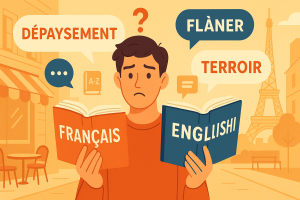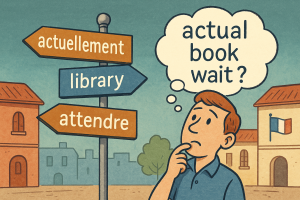Best way to learn French for English speakers — what actually works (A1–C1)
Thousands of French learning methods compete for your attention, each promising the fastest path to fluency. This evidence-based guide cuts through marketing hype to reveal what actually works for English speakers learning French, leveraging your native language advantages while avoiding common pitfalls that waste time and money.

The uncomfortable truth — there’s no single “best” method
Language learning research reveals an inconvenient reality: no single method works optimally for everyone. The “best” approach depends on your learning style, available time, budget, goals, current level, and personal circumstances. Someone learning French for business communication needs different strategies than someone preparing to read French literature or planning casual travel conversations.
However, certain principles and practices consistently produce better results than alternatives regardless of individual differences. Successful French learners combine structured grammar study with immersive practice, balance input (reading/listening) with output (speaking/writing), leverage their English vocabulary advantages while avoiding interference, and maintain consistent daily practice rather than sporadic intensive bursts. These evidence-based principles form the foundation of effective learning regardless of specific method chosen.
This guide synthesizes research findings, polyglot experiences, and teaching expertise to identify genuinely effective strategies while exposing common approaches that seem productive but waste time. Understanding realistic timelines and evidence-based methods prevents discouragement from unrealistic expectations while maximizing progress toward your specific French goals.
Leverage your English speaker advantages
The massive vocabulary head start
English speakers begin French study with an extraordinary advantage: approximately thirty percent of English vocabulary derives from French through Norman conquest (1066) and subsequent centuries of cultural exchange. Words like “restaurant,” “government,” “justice,” “parliament,” “chocolate,” and thousands more require zero memorization—you already know them. This shared vocabulary foundation accelerates early progress dramatically compared to speakers of languages with no Romance influence.
Strategic learners exploit this advantage by recognizing patterns in French-English cognates. Many English words ending in “-tion” translate directly to French with identical spelling and similar pronunciation: “information,” “nation,” “population,” “education.” English words ending in “-ity” typically become “-ité” in French: “university” → “université,” “quality” → “qualité.” English adjectives ending in “-ous” often become “-eux/-euse”: “dangerous” → “dangereux,” “curious” → “curieux.”
💡 Cognate strategy: When encountering new French words, check if they resemble English words before consulting dictionaries. This pattern recognition builds vocabulary faster while strengthening your intuition for French-English relationships.
Beware the false friend trap
Shared vocabulary creates both advantages and hazards. False friends—words that look similar but mean different things—cause persistent errors. “Actuellement” means “currently” not “actually.” “Assister à” means “to attend” not “to assist.” “Demander” means “to ask” not “to demand.” These deceptive similarities require explicit study to overcome automatic English assumptions.
Shared grammatical structures
French and English share fundamental sentence structures (subject-verb-object), similar question formation patterns, and comparable logical organization. This structural similarity means English speakers grasp basic French grammar concepts faster than speakers of languages with radically different syntax like Japanese or Arabic. Leverage this advantage by recognizing parallel structures rather than treating French grammar as entirely foreign territory.
The optimal learning system — combining complementary methods
Foundation: Structured curriculum (30-40% of study time)
Why it works: Systematic progression through core competencies ensures comprehensive coverage of essential grammar, vocabulary, and skills rather than scattered random exposure.
Best approaches:
- Professional instruction: Structured lessons with qualified teachers provide immediate feedback, error correction, personalized guidance, and accountability
- Quality textbooks: Comprehensive courses like “Grammaire Progressive du Français” or “Alter Ego” provide systematic grammar explanations, progressive exercises, and balanced skill development
- Structured online platforms: Programs like Frantastique or Lingoda offer adaptive lessons, grammar explanations, and structured progression
What to avoid: Jumping between multiple courses without completing any, skipping foundational grammar, relying solely on apps without systematic instruction
Immersion: Authentic French content (30-40% of study time)
Why it works: Exposure to authentic French develops listening comprehension, reveals natural usage patterns, builds cultural knowledge, and maintains motivation through engaging content.
Best approaches:
- Graded readers: Books written specifically for learners at each level provide comprehensible input with controlled vocabulary
- French media: Netflix shows with French audio and subtitles, French podcasts at your level, French YouTube channels
- News sources: Read simplified French news like “Le Journal en Français Facile” before progressing to standard media
- Music and radio: French songs with lyrics, radio stations like France Inter for background exposure
What to avoid: Only consuming content far above your level, passive watching without active engagement, never challenging yourself with slightly difficult material
Production: Active speaking and writing (20-30% of study time)
Why it works: Productive skills require separate practice from receptive skills. Speaking and writing force you to construct sentences actively, revealing gaps in knowledge that passive consumption masks.
Best approaches:
- Regular tutoring sessions: Weekly conversation practice with native speakers or qualified teachers provides essential speaking experience
- Language exchange: Free conversation practice with French learners of English through platforms like Tandem or HelloTalk
- Writing practice: Daily journaling in French, posting in French forums, writing short essays for correction
- Shadowing: Repeating after native speakers to improve pronunciation and fluency
- Self-talk: Narrating daily activities in French, thinking in French, talking to yourself
What to avoid: Waiting until you feel “ready” to speak, only studying without producing, fearing mistakes so much you never practice
Reinforcement: Spaced repetition and review (10-20% of study time)
Why it works: Memory consolidation requires reviewing material at optimal intervals. Spaced repetition systems maximize retention efficiency by scheduling reviews when you’re about to forget.
Best approaches:
- Anki or Memrise: Digital flashcard systems that automatically schedule optimal review intervals
- Regular grammar review: Revisiting challenging concepts periodically rather than “learn once and forget”
- Vocabulary notebooks: Personal collections of new words with example sentences, reviewed weekly
What to avoid: Creating thousands of cards you never review, passive card flipping without active recall, memorizing isolated words without context
The daily practice formula that works
Consistency matters more than intensity. Thirty minutes daily outperforms three-hour weekend sessions for language retention. Distributed practice allows consolidation between sessions, prevents cognitive overload, and maintains momentum. Build a sustainable daily routine rather than unsustainable heroic efforts.
Sample daily schedule for different time commitments
30 minutes daily (minimum effective dose):
– 10 minutes: Structured lesson or grammar study
– 10 minutes: Vocabulary review with spaced repetition
– 10 minutes: Listening practice (podcast, video, or audio lesson)
1 hour daily (optimal for steady progress):
– 20 minutes: Structured curriculum work
– 15 minutes: Reading French texts at your level
– 15 minutes: Listening practice
– 10 minutes: Speaking practice (shadowing, self-talk, or recording yourself)
2+ hours daily (accelerated progress):
– 30 minutes: Structured lesson or grammar study
– 30 minutes: Conversation practice with tutor or language partner
– 30 minutes: Immersive content (shows, podcasts, reading)
– 15 minutes: Writing practice
– 15 minutes: Vocabulary review and consolidation
💡 Habit stacking tip: Attach French practice to existing daily routines. Coffee time = French podcast. Commute = vocabulary review. Evening routine = ten minutes French reading. These automatic triggers build consistent practice without relying on motivation alone.
Common mistakes English speakers make
Mistake 1: Avoiding speaking until feeling “ready”
Many English speakers delay speaking practice until achieving perfect grammar knowledge, creating a vicious cycle where lack of practice prevents developing the very skills needed for confident communication. Native speakers make grammatical errors constantly without communication breakdown. Start speaking from day one, accept errors as learning opportunities, and prioritize communicative competence over grammatical perfection.
Mistake 2: Neglecting pronunciation from the beginning
English speakers often defer pronunciation practice until after building vocabulary and grammar knowledge. This approach allows fossilized errors to develop—permanent mispronunciations that become difficult to correct later. French pronunciation differs significantly from English through nasal vowels, the French R, liaison patterns, and silent letters. Establish correct pronunciation from day one through shadowing native speakers, focused practice on difficult sounds, and recording yourself for comparison.
Mistake 3: Translating everything mentally
Constantly translating French to English creates slow, labored communication and prevents developing true French thinking. While translation helps initially, transition toward comprehending French directly as your level advances. Use context clues, visual associations, and French definitions rather than always reaching for English equivalents. This mental shift marks the transition from beginner to intermediate proficiency.
Mistake 4: Studying in isolation without feedback
Self-study using apps and books feels productive but provides no error correction, pronunciation feedback, or communicative practice. Combine independent study with regular sessions where native speakers or qualified teachers provide feedback, correct errors, answer questions, and push you beyond your comfort zone. This hybrid approach balances efficiency with effectiveness.
⚠️ The app trap: Language learning apps like Duolingo provide convenient gamified practice but cannot replace comprehensive study. Use apps as supplements for vocabulary review and basic practice, not as complete learning systems. Apps excel at building habits and covering basics but prove insufficient for developing genuine conversational fluency.
Mistake 5: Passive consumption without active engagement
Watching French shows, listening to podcasts, and reading texts provide valuable exposure but don’t automatically transfer to productive abilities. Balance passive consumption with active engagement: repeat phrases out loud, write summaries, answer comprehension questions, shadow speakers, discuss content. Active processing transforms passive exposure into usable skills.
Adapting your approach by proficiency level
Beginner (A1-A2): Build solid foundations
Primary focus: Systematic grammar instruction, high-frequency vocabulary, basic pronunciation, simple conversation practice
Best methods: Structured courses with clear explanations, speaking practice from day one even with limited vocabulary, comprehensible input through graded readers, consistent daily exposure
Success markers: Can introduce yourself, order in cafés and restaurants, understand simple texts, ask basic questions, form simple sentences in present tense
Intermediate (B1-B2): Expand and consolidate
Primary focus: Vocabulary expansion through context, complex grammar structures, extended conversations, authentic content consumption, productive skills development
Best methods: Regular conversation practice with tutors, reading authentic texts with manageable difficulty, writing for correction, consuming French media actively, transitioning from translation to direct comprehension
Success markers: Can discuss abstract topics, understand main ideas in authentic media, read contemporary texts with occasional dictionary use, express nuanced opinions, handle most travel situations independently
Advanced (C1-C2): Refine and specialize
Primary focus: Subtle distinctions between near-synonyms, idiomatic expressions, specialized vocabulary for your interests, cultural knowledge, native-like fluency
Best methods: Immersion in authentic content for your field, reading challenging literature, discussing complex topics with natives, formal writing practice, consuming academic or professional French content
Success markers: Can understand virtually everything heard or read, express yourself fluently and precisely, use French professionally, grasp subtle connotations, participate in sophisticated discussions
The role of different learning tools
Apps and software — convenient but limited
Best for: Building daily habits, vocabulary review, basic grammar practice, pronunciation exercises
Limitations: Cannot provide conversational practice, personalized feedback, or comprehensive instruction
Recommended uses: Supplement to structured study, not primary method; daily vocabulary maintenance; quick review sessions
Textbooks and courses — systematic but dry
Best for: Comprehensive grammar coverage, structured progression, reference material, systematic skill development
Limitations: Can feel tedious, lack real-world context, provide no speaking practice
Recommended uses: Primary structure for beginners and intermediates; grammar reference; systematic foundation building
Tutors and teachers — effective but expensive
Best for: Speaking practice, immediate error correction, personalized instruction, motivation and accountability
Limitations: Cost, scheduling logistics, quality varies significantly
Recommended uses: Weekly conversation practice, grammar clarification, pronunciation feedback, progress assessment
Immersion content — engaging but overwhelming
Best for: Listening comprehension, cultural knowledge, natural usage patterns, motivation through interest
Limitations: Can exceed comprehension level, provides no structured instruction or feedback
Recommended uses: Daily exposure at appropriate difficulty, cultural learning, maintaining motivation, supplementing structured study
Language exchanges — free but unfocused
Best for: Free speaking practice, cultural exchange, making friends, real conversation experience
Limitations: No formal structure, time split between languages, partner may lack teaching skills
Recommended uses: Supplementing paid instruction, practicing specific topics, cultural conversation, budget-friendly speaking practice
Creating your personalized learning plan
Step 1: Define specific goals
Transform vague “learn French” into concrete targets: “Pass DELF B1 exam in twelve months,” “Hold thirty-minute conversation about work and hobbies,” “Read French newspaper articles with minimal dictionary use,” “Navigate two-week France trip independently.” Specific goals enable progress measurement and maintain motivation through clear milestones.
Step 2: Assess current level honestly
Take a placement test or self-assessment to determine your actual current level. Beginners often overestimate their abilities while intermediates underestimate. Accurate assessment prevents wasting time on material too easy or frustration from content too difficult.
Step 3: Identify available resources
Inventory your constraints and resources: available study time daily, budget for materials and instruction, access to French speakers, learning environment, existing materials. Design realistic plans fitting your actual circumstances rather than ideal but unachievable systems.
Step 4: Build balanced weekly schedule
Allocate time across all skill areas: structured study, listening practice, reading, speaking, writing, vocabulary review. Include rest days to prevent burnout. Schedule specific times rather than vague “I’ll study when I can”—treat French practice as non-negotiable appointments.
Step 5: Review and adjust monthly
Evaluate progress monthly: What’s working? What feels ineffective? Where are you stuck? Adjust methods, resources, or schedule based on results rather than rigidly following initial plan regardless of effectiveness. Successful learners iterate toward optimal personal systems through experimentation and reflection.
Study glossary — learning method vocabulary
| EN | FR | Definition |
|---|---|---|
| Structured curriculum | Programme structuré | Systematic course covering all competencies |
| Immersion | Immersion | Complete exposure to target language |
| Spaced repetition | Répétition espacée | Review system optimizing memory retention |
| Comprehensible input | Input compréhensible | Content slightly above current level |
| Active production | Production active | Speaking and writing practice |
| Passive consumption | Consommation passive | Listening and reading without production |
| Shadowing | Technique du shadowing | Repeating after native speakers |
| Language exchange | Échange linguistique | Reciprocal practice with language partners |
| Fossilized error | Erreur fossilisée | Permanent mistake from uncorrected habit |
| Cognate | Mot apparenté | Similar word in both languages |
| False friend | Faux ami | Similar word with different meaning |
| Graded reader | Lecture graduée | Text simplified for learner level |
Authoritative references
- Foreign Service Institute — research on effective language learning methods.
- Council of Europe CEFR — standardized proficiency framework.
Learn French with Roger, Native French Tutor
Expert instruction with proven teaching methods. Personalized lessons tailored to your goals from A0 to C1.
Weekly Lessons with Roger
Learn with Roger, a native French tutor. Structured curriculum from beginner to advanced.
- Native French speaker from France
- All levels (A0-C1) supported
- Personalized curriculum
- Proven teaching methodology
Trial Lesson with Roger
Experience Roger’s teaching method with a 25-minute trial session. Perfect to get started.
- 25 minutes with Roger
- Level assessment included
- Personalized learning roadmap
- No commitment required
A1 Foundations Guide
Complete beginner’s guide created by Roger. Structured lessons with native pronunciation.
- Step-by-step A1 curriculum
- Audio by native French speaker
- Practice exercises included
- Learn at your own pace
Continue Learning
Check out these related articles

15 French words that don’t translate to English — complete guide (A1–B1)
Discover 15 essential French words with no direct English translation, learn what they really mean, how to use them naturally,…

French restaurant booking phrases (A0–A2) — reserve, arrive, order
french restaurant booking phrases help you secure a table, arrive smoothly, and start the meal with confidence. This A0–A2 guide…

Common French false friends that confuse English speakers — complete guide (A1–B1)
Master French false friends that confuse English speakers with clear explanations, memory tricks, bilingual examples with IPA, and practical sentences…
👋 Join Our Community
Follow us for daily tips, pronunciation tricks, and free resources
👍 Follow on Facebook